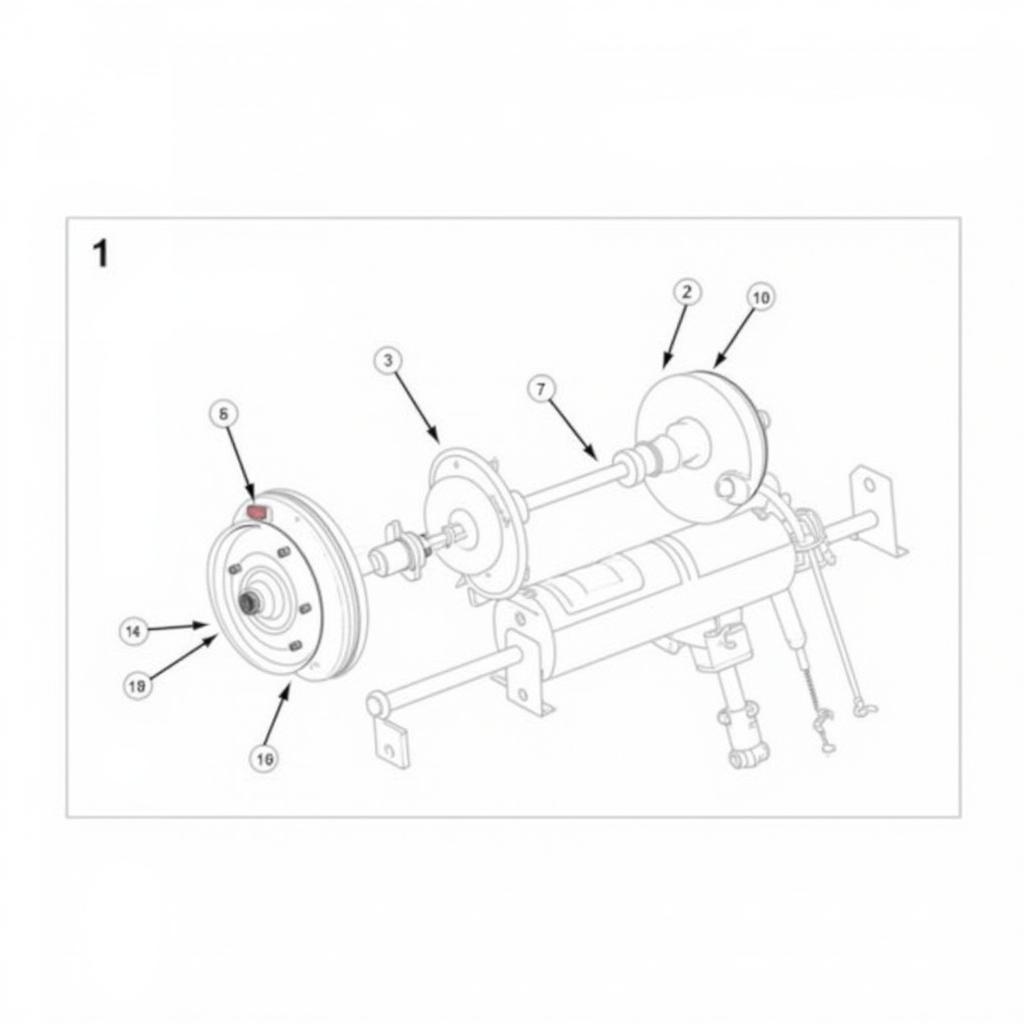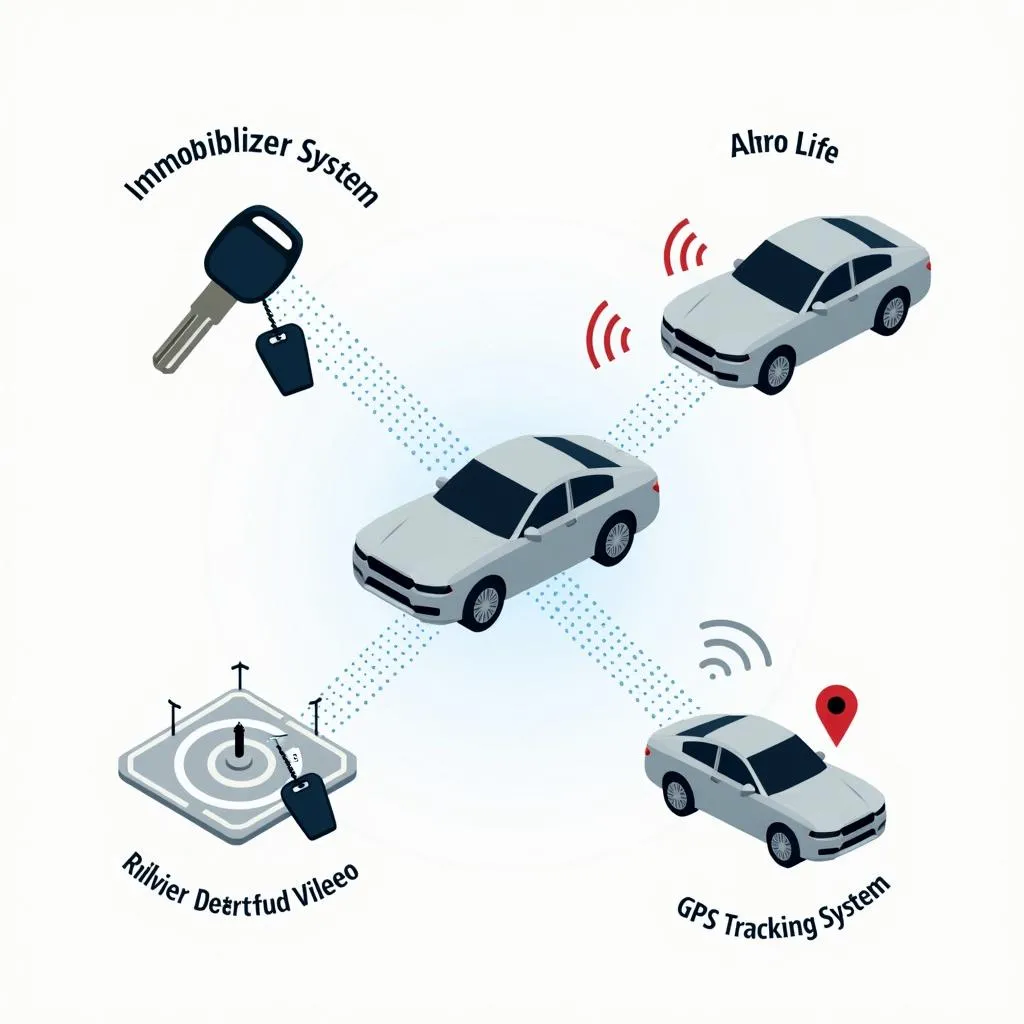The brake warning light on your Hyundai Santa Fe dashboard is a crucial safety feature. When it illuminates, it signals a potential issue within your braking system that requires immediate attention. Ignoring this warning light could lead to brake failure and dangerous driving conditions. This article will guide you through the common causes of a Hyundai Santa Fe brake warning light and provide potential solutions to get you back on the road safely.
Understanding Your Hyundai Santa Fe Brake System
Before diving into the causes, it’s helpful to have a basic understanding of how your Hyundai Santa Fe’s brake system works. The system is comprised of several key components, including:
- Brake Pedal: This is where you, the driver, initiate the braking action.
- Brake Booster: This component amplifies the force you apply to the brake pedal, making braking easier.
- Master Cylinder: When you press the brake pedal, this cylinder pressurizes brake fluid.
- Brake Lines: These lines carry the pressurized fluid to the brakes at each wheel.
- Brake Calipers and Wheel Cylinders: These components use the pressurized fluid to clamp the brake pads against the rotors (disc brakes) or drums (drum brakes), slowing or stopping your vehicle.
 Hyundai Santa Fe Brake System Diagram
Hyundai Santa Fe Brake System Diagram
Common Causes of a Hyundai Santa Fe Brake Warning Light
There are several reasons why your Hyundai Santa Fe brake warning light might turn on. Here are some of the most common culprits:
1. Low Brake Fluid Level
One of the most frequent reasons for the brake warning light is low brake fluid. Brake fluid is the lifeblood of your braking system. As brake pads wear down, the brake fluid level naturally decreases. However, a leak in the system can also cause a rapid drop in fluid level.
How to check:
- Locate the brake fluid reservoir under the hood of your car. It’s usually a translucent plastic container with a black cap.
- Check the fluid level against the “MIN” and “MAX” markings on the reservoir.
- If the fluid is below the minimum line, add the correct brake fluid for your Hyundai Santa Fe (consult your owner’s manual).
Important Note: If you need to add brake fluid frequently, it indicates a leak that needs to be addressed immediately by a qualified mechanic.
2. Worn Brake Pads
Brake pads are designed to wear down over time. When they become too thin, the brake warning light will illuminate. This is a normal part of wear and tear, but ignoring it can lead to more serious (and costly) damage to your brake system.
How to tell if your brake pads are worn:
- Squealing or screeching noises when braking: This is often the first sign of worn brake pads.
- Grinding noise when braking: This is a serious sign that your pads are completely worn down, and metal is grinding on metal. This can damage your rotors and require expensive repairs.
- Vibrations in the brake pedal: Worn brake pads can also cause vibrations or pulsations in the brake pedal when braking.
What to do: If you suspect worn brake pads, it’s crucial to have them inspected and replaced by a mechanic as soon as possible.
3. Faulty Brake Light Switch
The brake light switch is a small sensor located near the brake pedal. When you press the brake, this switch activates the brake lights. A faulty switch can cause the brake warning light to come on, even if there’s nothing wrong with your brakes themselves.
How to tell if it’s the brake light switch: If your brake lights aren’t working correctly (either staying on constantly or not coming on at all), the switch is likely the culprit.
What to do: Replacing a brake light switch is relatively inexpensive. A mechanic can diagnose and replace the switch for you.
4. ABS (Anti-lock Braking System) Issue
Modern Hyundai Santa Fe models are equipped with an Anti-lock Braking System (ABS). This safety feature prevents the wheels from locking up during hard braking, helping you maintain control of the vehicle. If there’s a problem with your ABS system, the brake warning light may illuminate along with the ABS warning light.
Common ABS issues:
- Faulty ABS wheel speed sensor: These sensors monitor the speed of each wheel. A faulty sensor can disrupt the ABS system.
- Problem with the ABS control module: This module is the brain of the ABS system. If it malfunctions, the entire system can be affected.
What to do: Diagnosing ABS problems requires specialized equipment. It’s best to have your vehicle checked by a qualified mechanic or dealership.
5. Other Less Common Causes
While less common, the following issues can also trigger the brake warning light on your Hyundai Santa Fe:
- Emergency brake is engaged: Make sure you haven’t accidentally left the parking brake partially engaged.
- Faulty brake caliper: A seized or malfunctioning brake caliper can affect brake fluid pressure and illuminate the warning light.
- Issues with the master cylinder: A leaking or malfunctioning master cylinder can cause a loss of brake fluid pressure.
- Electrical problems: Wiring issues or a faulty sensor in the braking system can trigger false warning lights.
What to Do When Your Brake Warning Light Comes On
1. Stay Calm and Assess the Situation: Don’t panic! If the light comes on while you’re driving, safely pull over to the side of the road.
2. Check the Brake Fluid Level: As mentioned earlier, this is a quick and easy check you can do yourself.
3. Listen for Unusual Noises: Pay attention to any squealing, grinding, or clicking sounds coming from your brakes.
4. Don’t Delay Professional Inspection: Even if your brake fluid level seems fine and you don’t hear any unusual noises, it’s always best to have your Hyundai Santa Fe inspected by a qualified mechanic as soon as possible. They have the tools and expertise to diagnose the problem accurately.
Resetting the Brake Warning Light
In some cases, after addressing the underlying issue (like adding brake fluid or replacing brake pads), the warning light might remain illuminated. You may need to reset the light manually. The procedure for resetting the brake warning light on a Hyundai Santa Fe can vary depending on the model year. Refer to your owner’s manual for specific instructions or consult with a mechanic.
Prevention is Key
Regular maintenance is crucial to prevent brake problems. Here are some preventative measures:
- Regular Brake Inspections: Have your brakes inspected at least once a year or every 12,000 miles.
- Brake Fluid Flush: It’s generally recommended to flush your brake fluid every 2 years or 24,000 miles to ensure optimal performance.
- Quality Brake Pads: Use high-quality brake pads for longer lifespan and better braking performance.
- Avoid Riding the Brakes: Constantly keeping your foot on the brake pedal can lead to premature wear.
Driving Safely with Your Hyundai Santa Fe
By understanding the common causes of a brake warning light, taking prompt action, and practicing preventative maintenance, you can ensure the safety and reliability of your Hyundai Santa Fe’s braking system. Remember, your safety is paramount, and never hesitate to seek professional help when dealing with brake issues.
FAQs About Hyundai Santa Fe Brake Warning Lights
1. Can I drive my Hyundai Santa Fe with the brake warning light on?
It’s strongly advised against driving with the brake warning light on. It indicates a potential problem with your braking system, and continuing to drive could be dangerous.
2. How much does it cost to fix a Hyundai Santa Fe brake light issue?
The cost of repair depends on the underlying cause. A simple brake fluid top-up might cost very little, while a brake pad replacement or a more complex ABS repair could be significantly more expensive.
3. How often should I change my Hyundai Santa Fe brake pads?
Brake pad lifespan can vary greatly depending on driving habits and conditions. It’s best to have them checked regularly and replaced as soon as you notice signs of wear.
4. Is it safe to reset the brake light myself?
If you’re comfortable with basic car maintenance and have the correct instructions, you can likely reset the light yourself. However, if you’re unsure, it’s always best to consult with a professional.
5. Can I use any brake fluid in my Hyundai Santa Fe?
No, using the incorrect type of brake fluid can damage your brake system. Consult your owner’s manual or a mechanic to determine the correct type of brake fluid for your specific Hyundai Santa Fe model.

